ZELDA NO DENSETSU
The Hyrule Fantasy
|
|
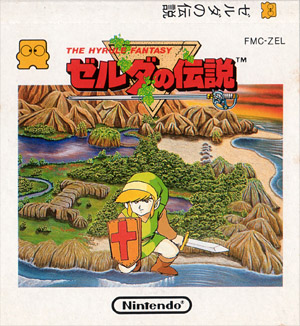
|

|
|
ゼルダの伝説
©1986 Nintendo
Release: 1986-02-21 (¥2600)
DiskCard FMC-ZEL
Adventure / Action game
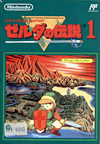
|

Released in Japan (Cartridge) as
ZELDA NO DENSETSU
( HVC-ZL )
|
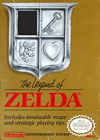
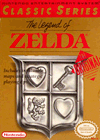
|

Released in America (Cartridge) as
THE LEGEND OF ZELDA
( NES-ZL-USA ) & ( NES-ZL-USA-1 )
|
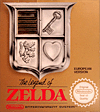
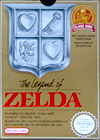
|

Released in Europe (Cartridge) as
THE LEGEND OF ZELDA
( NES-ZL-XXX )
|
|
Zelda no Densetsu is an action/adventure game by Nintendo.
Do we still need to present Shigeru Miyamoto's Zelda no Densetsu ?
For anyone who has been hiding under a rock or living in a cave for the past
twenty years, here's a short introduction to this milestone in video gaming
history. A long time ago, in the kingdom of Hyrule, the legend of the
magical Triforce of wisdom was told from generation to generation. Alas,
one day, the evil Ganon plot to steal this immense source of power. In a
desperate attempt to save the kingdom, princess Zelda has no choice but
to split up the Triforce into eight pieces and to hide them throughout
the country. Before she finds herself kidnaped and imprisoned, she sends her
bravest friend, the nursemaid Impa, to find a warrior courageous enough to
defeat Ganon. Link, a valiant young boy, happens to be the
chosen one and he soon embarks on a long quest to defeat Ganon and to
rescue princess Zelda. The game is displayed through an top-down view
and offers a balance of adventure, exploration and action. Unlike most of the
Role Playing games of the time, fights are not random based and are instead
tightly and seamlessly integrated with the gameplay. Furthermore, Link
doesn't level up - instead, new weapons and items (such as shields, swords,
bombs, boomerangs, bows, heart containers and so forth) increase his strength
and skills as he progresses through his journey. This first episode definitively
paves the way to the Zelda series as we know it, and it follows the simple
gameplay formula rightfully quoted in the Family Computer Expo Catalog
printed in 1994 : "the one who should mature is not the character but the
player". The world of Hyrule is also surprisingly large for a game
released in 1986 and Link's journey requires him to travel through the
remotest places of the overworld and explore the treacherous dungeons
from the underworld. Players diligent enough to complete the game will
also unlock a more difficult and different Second Quest featuring tougher
enemies and rearranged dungeons.
|
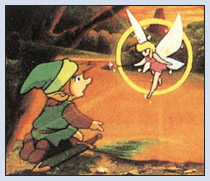 Zelda no Densetsu: The Hyrule Fantasy was first released in Japan in 1986
(aka The Legend of Zelda in American and Europe). Its sequel, called
The Legend of Zelda 2: Link no Bōken in Japan (aka Zelda II: The
Adventure of Link in America and Europe), followed in 1987. Curiously this
title was very different, introducing side-scrolling areas and game mechanics
based on experience points. Two games followed and strengthen the
franchise - Zelda no Densetsu: Kamigami no Tri-Force
(aka Legend of Zelda: A Link to the Past) released for the Super Famicom system
in 1991 and The Legend of Zelda: Link's Awakening released for the Game Boy the
following year (remade in 1998 for the Game Boy Color). Another obscure Zelda
title came out in 1997 for Nintendo's Stellaview. The game, called BS Zelda
was broadcasted an hour at the time in Japan and intensively used A Link to the Past's game
engine. But players will have to wait seven long years for a proper Zelda title to appear
after Link to the past. Nonetheless, it was worth the wait and in 1998 came the first full
3D installment of the series. Zelda no Densetsu: Toki no Ocarina (aka
The Legend of Zelda : The Ocarina of Time) was a huge success (with over 7
million sales worldwide) and a sequel followed two years later with Zelda no Densetsu: Majora no Kamen
(aka The Legend of Zelda : Majora's Mask) which featured a cleverly designed three days structure.
Two titles followed in 2001 for the GameBoy Color and were developed in association with
Capcom - Zelda no Densetsu: Fushigi na Ki no Mi - Daichi no Shō
(aka Legend of Zelda: Oracle of Seasons) and
Zelda no Densetsu: The Hyrule Fantasy was first released in Japan in 1986
(aka The Legend of Zelda in American and Europe). Its sequel, called
The Legend of Zelda 2: Link no Bōken in Japan (aka Zelda II: The
Adventure of Link in America and Europe), followed in 1987. Curiously this
title was very different, introducing side-scrolling areas and game mechanics
based on experience points. Two games followed and strengthen the
franchise - Zelda no Densetsu: Kamigami no Tri-Force
(aka Legend of Zelda: A Link to the Past) released for the Super Famicom system
in 1991 and The Legend of Zelda: Link's Awakening released for the Game Boy the
following year (remade in 1998 for the Game Boy Color). Another obscure Zelda
title came out in 1997 for Nintendo's Stellaview. The game, called BS Zelda
was broadcasted an hour at the time in Japan and intensively used A Link to the Past's game
engine. But players will have to wait seven long years for a proper Zelda title to appear
after Link to the past. Nonetheless, it was worth the wait and in 1998 came the first full
3D installment of the series. Zelda no Densetsu: Toki no Ocarina (aka
The Legend of Zelda : The Ocarina of Time) was a huge success (with over 7
million sales worldwide) and a sequel followed two years later with Zelda no Densetsu: Majora no Kamen
(aka The Legend of Zelda : Majora's Mask) which featured a cleverly designed three days structure.
Two titles followed in 2001 for the GameBoy Color and were developed in association with
Capcom - Zelda no Densetsu: Fushigi na Ki no Mi - Daichi no Shō
(aka Legend of Zelda: Oracle of Seasons) and
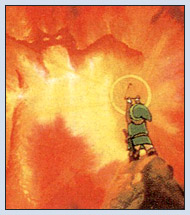 Zelda no Densetsu: Fushigi na Ki no Mi - Jikū no Shō (aka Legend of Zelda: Oracle of Ages).
Despite being connected, the two games are fully self contained and can be completed separately. Then,
in 2002, the cartoon cell-shaded Zelda no Densetsu: Kaze no Takuto
(aka The Legend of Zelda: The Wind Waker) appeared for the Game Cube. As a side note,
a special version of Ocarina of Time, called Ura Zelda (aka Ocarina of Time Master Quest)
was made available to players who pre-ordered The Wind Waker. Interestingly, Ura Zelda
was originally supposed to be the real sequel to Ocarina of Time back in 2001 but
Majora's Mask was picked up instead. The same year, a remake of A Link to the Past
was released for the GameBoy Advance. It came with an extra side quest, called
The Four Swords, which allowed up to four players to play at the same time.
Interestingly, Zelda no Densetsu: 4tsu no Tsurugi (aka The Legend of Zelda: Four Swords Adventures)
followed for the GameCube in 2004 and is a sort of sequel to The Four Swords.
Zelda no Densetsu: Fushigi no Bōshi (aka The Legend of Zelda: The Minish Cap)
was then released in 2004 and featured the tiny Minish people. The latest episode were
Zelda no Densetsu: Twilight Princess (aka The Legend of Zelda: Twilight Princess)
released in 2006 for the GameCube and Wii, Zelda no Densetsu: Mugen no Sunadokei
(The Legend of Zelda: Phantom Hourglass) (DS, 2007) and The Legend of Zelda: Spirit Tracks
(Nintendo DS, 2009).
Zelda no Densetsu: Fushigi na Ki no Mi - Jikū no Shō (aka Legend of Zelda: Oracle of Ages).
Despite being connected, the two games are fully self contained and can be completed separately. Then,
in 2002, the cartoon cell-shaded Zelda no Densetsu: Kaze no Takuto
(aka The Legend of Zelda: The Wind Waker) appeared for the Game Cube. As a side note,
a special version of Ocarina of Time, called Ura Zelda (aka Ocarina of Time Master Quest)
was made available to players who pre-ordered The Wind Waker. Interestingly, Ura Zelda
was originally supposed to be the real sequel to Ocarina of Time back in 2001 but
Majora's Mask was picked up instead. The same year, a remake of A Link to the Past
was released for the GameBoy Advance. It came with an extra side quest, called
The Four Swords, which allowed up to four players to play at the same time.
Interestingly, Zelda no Densetsu: 4tsu no Tsurugi (aka The Legend of Zelda: Four Swords Adventures)
followed for the GameCube in 2004 and is a sort of sequel to The Four Swords.
Zelda no Densetsu: Fushigi no Bōshi (aka The Legend of Zelda: The Minish Cap)
was then released in 2004 and featured the tiny Minish people. The latest episode were
Zelda no Densetsu: Twilight Princess (aka The Legend of Zelda: Twilight Princess)
released in 2006 for the GameCube and Wii, Zelda no Densetsu: Mugen no Sunadokei
(The Legend of Zelda: Phantom Hourglass) (DS, 2007) and The Legend of Zelda: Spirit Tracks
(Nintendo DS, 2009).
|
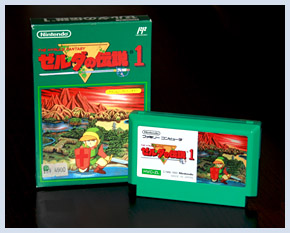 The original Famicom Disk version of Zelda No Densetsu was, I believe,
the first game ever released for the Famicom Disk System. The American
version came out in two flavors - the original golden cartridge edition and a more
traditional Classic Series featuring a grey cartridge. Interestingly,
Zelda No Densetsu was released again in Japan in 1994 - it was renamed
Zelda no Densetsu 1: The Hyrule Fantasy and came out on cartridge (picture on the left). As
a side note, the original Japanese Famicom Disk version used the microphone
located on the second player's controller. Shouting into the microphone would weaken
the big ears creatures called Pols Voice found in some dungeons. This feature was of course removed
from the American and European versions, the microphone not being part of the
original Nintendo Entertainment System. Despite this, the game documentation
still mentioned something about some creature hating "loud noises"
(quote from the American manual : "Pols Voice - A ghost with big ears and a
weak point - he hates loud noise"). This straight translation from the Japanese
manual is a sort of 'lost in translation' mistake which probably confused a whole
generation of players back in the days.
The original Famicom Disk version of Zelda No Densetsu was, I believe,
the first game ever released for the Famicom Disk System. The American
version came out in two flavors - the original golden cartridge edition and a more
traditional Classic Series featuring a grey cartridge. Interestingly,
Zelda No Densetsu was released again in Japan in 1994 - it was renamed
Zelda no Densetsu 1: The Hyrule Fantasy and came out on cartridge (picture on the left). As
a side note, the original Japanese Famicom Disk version used the microphone
located on the second player's controller. Shouting into the microphone would weaken
the big ears creatures called Pols Voice found in some dungeons. This feature was of course removed
from the American and European versions, the microphone not being part of the
original Nintendo Entertainment System. Despite this, the game documentation
still mentioned something about some creature hating "loud noises"
(quote from the American manual : "Pols Voice - A ghost with big ears and a
weak point - he hates loud noise"). This straight translation from the Japanese
manual is a sort of 'lost in translation' mistake which probably confused a whole
generation of players back in the days.
|
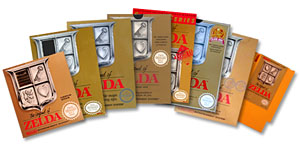 Zelda can make any label or edition variation collector's heart leap.
Although the Japanese version of the game seems fairly straightforward (despite the
Disk/Cartridge prints), the American and European versions span over a vast
array of label and cartridge variations :
Zelda can make any label or edition variation collector's heart leap.
Although the Japanese version of the game seems fairly straightforward (despite the
Disk/Cartridge prints), the American and European versions span over a vast
array of label and cartridge variations :
As for north America, Zelda was first released
on a golden cartridge (serial NES-ZL-USA). However two box variations exist, one with a white Nintendo
seal, the other one with a grey seal. Then the game was released again in the NES Classic
Series and included a grey cartridge (serial NES-ZL-USA-1). Finally, an really rare orange Zelda
test cartridge also exists (serial NES-ZL-USA).
As for Europe, things are a lot more complicated. The game was also first released on
a golden cartridge and also featured two different Nintendo seals, one white and the
other grey. However, some variations have the seal on the lower-right corner of the box whereas
others have it centered on the right. A really rare variation also features two grey Nintendo seals !
Another variation of the game was released in a smaller box. Finally, a
Classic Series also exist but looks completely different than the American version.
|
Teaser text from the American version:
Welcome to THE LEGEND OF ZELDA. Where the
only sound you'll hear if your own heart pounding
as you race through the forests, lakes, mountains and
dungeonous mazes in an attempt to restore peace
to the land of Hyrule. Along the way you'll be
challenged by Tektites, Wizzrobes and an endless
array of ruthless creatures who'll stop at nothing
to prevent you from finding the lost fragments of
the Triforce of Wisdom. But don't despair. With a
little luck and a lot of courage, you'll conquer your
adversaries, unite the Triforce fragments and
unravel the mystery of THE LEGEND OF ZELDA!
|
Game Staff (Copied from the end credits) :
|
STAFF
Executive Producer
H. Yamauchi
Producer
S. Miyahon
|
|
Director
S. Miyahon
Ten ten
Designer
Ten Ten
|
|
Programmer
T. Nakazoo
Yachan
Marumaru
Sound Composer
Konchan
|
|
|
G
O
O
D
I
E
S
|
|
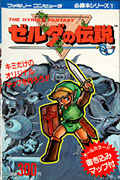
Japanese GuideBook
|
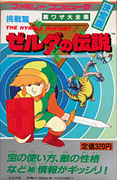
Japanese GuideBook
|
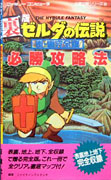
Japanese GuideBook
|
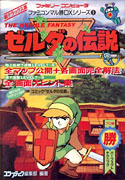
Japanese GuideBook
|
|
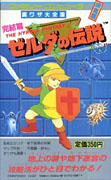
Japanese GuideBook
|
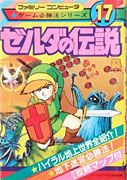
Japanese GuideBook
|
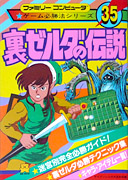
Japanese GuideBook
|
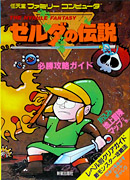
Japanese GuideBook
|
|
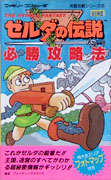
Japanese GuideBook
|
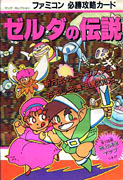
Japanese GuideBook
|
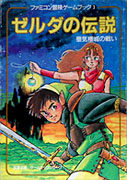
Japanese Adventure Book
|
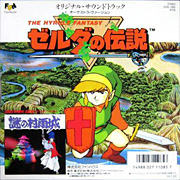
Japanese EP soundtrack
|
|
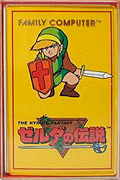
Japanese Playing Cards
|
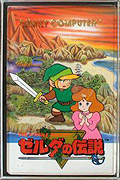
Japanese Playing Cards
|
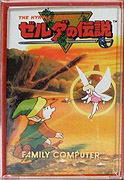
Japanese Playing Cards
|
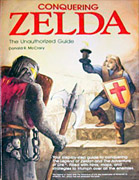
American GuideBook
|
|
|
O
M
A
K
E
|
|
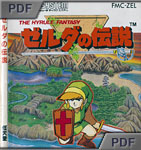
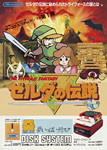
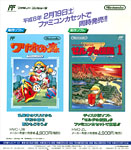



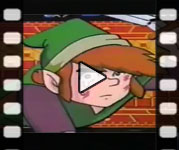
|
|
|
Click on picture to enlarge |
|
|
|
LK

|
|
Add your Pov here !
|
P
O
V
s
|
|
I am not sure if I can give Zelda no Densetsu all the justice and praise it deserves.
It is an absolute milestone of video game history. What I have always found amazing about the
Zelda series is the incredible soundtrack and the various sound effects such as the now
popular "success chime". Nintendo has stuck to these rules and even recent
Zelda titles feel instantly familiar because of this. The soundtrack and the sound
effects just instantly bring you back inside the Zelda universe, and this after only a
couple of minutes of play. Zelda no Densetsu also amazingly stands the test of time
and is highly enjoyable to play, even today. All the ingredients and conventions that made
Zelda such a classic are already reunited in this first episode. It is truly Nintendo
and Miyamoto San at their finest.
|
|
|
|